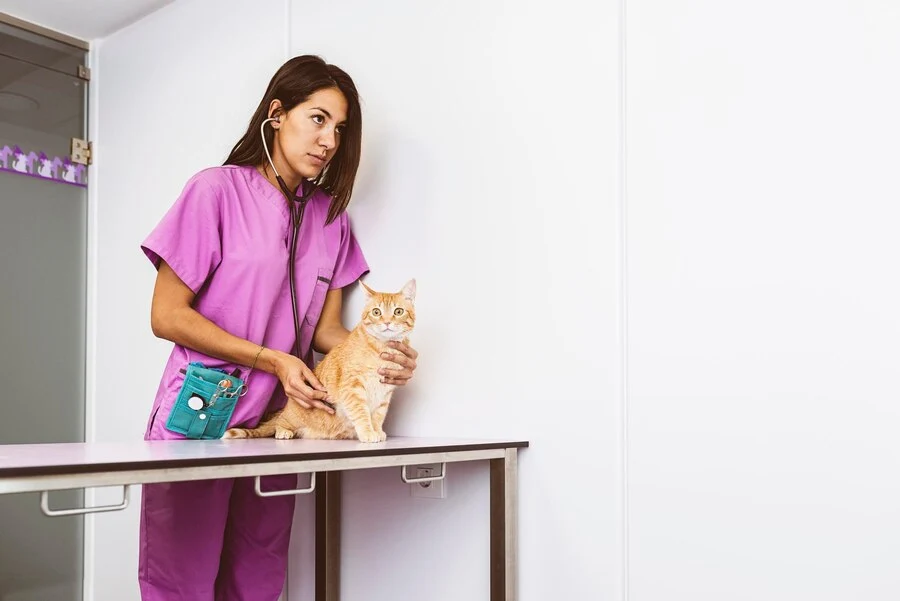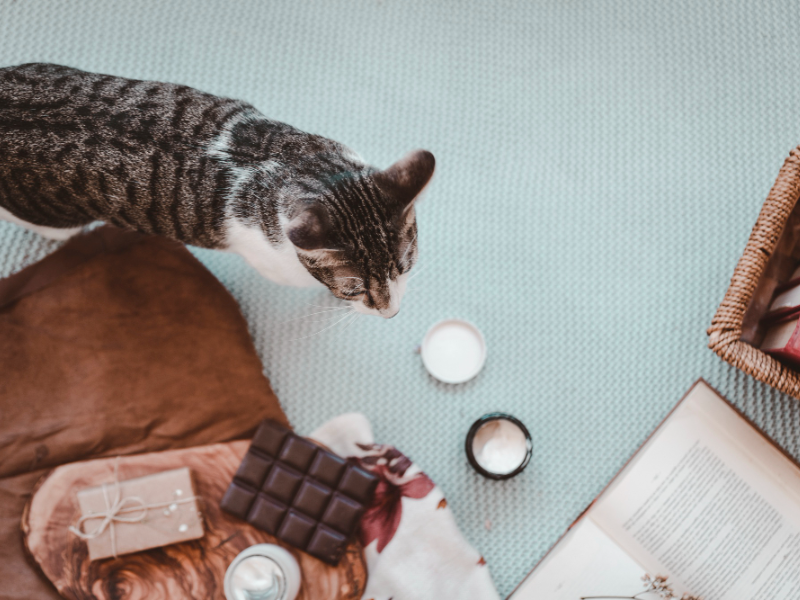Did you know even a small piece of chocolate can be deadly for your cat? Let’s dive deep into the dangers, symptoms, and prevention
First, talking about our feline friends, their health is what matters most. However, those furry little creatures manage to get into so much trouble with their curiosity when it comes to human food. So, Can cats eat Chocolate?
The short answer is no. Chocolate is very poisonous to cats and could pose severe health complications or be fatal. This article will look into just why chocolate is dangerous for cats, how to identify chocolate poisoning and ensure your furry friend’s safety.
Can Cats Eat Chocolate? A Closer Look
Chocolate contains two primary substances that are harmful to cats: theobromine and caffeine.
1. Theobromine
The key culprit behind chocolate toxicity is theobromine. Humans have no problem breaking it down, but cats metabolize it very slowly, which results in a buildup in tiny doses leading to a toxic situation.
- Effects on cats
Theobromine can over-stimulate a cat’s central nervous system and heart. In extreme cases, it may also cause kidney failure.
- High-Risk Chocolate Types
The greatest risk is in dark chocolate and baking chocolate, which have the highest concentration of theobromine.
2. Caffeine
Caffeine acts as a stimulant in both humans and animals. However, its impact on cats is far more severe, leading to:
- Rapid heart rate.
- Restlessness.
- Muscle tremors.
Expert Insight:
Did you know that even cocoa powder contains enough theobromine to harm your cat? Keep all cocoa products out of reach.
What Happens if a Cat Eats Chocolate?
When a cat ingests chocolate, their body is unable to metabolize the toxic compounds effectively, leading to a range of symptoms.

The Toxicity Timeline
- Within 1-4 hours
Early symptoms like vomiting, diarrhea, and restlessness.
- Within 6-12 hours
More severe signs such as rapid breathing, elevated heart rate, and tremors may appear.
- After 12 hours
Without intervention, symptoms can escalate to seizures, organ failure, or coma.
Factors That Influence Toxicity
1. Type of Chocolate
Dark chocolates and baking chocolates have a higher concentration of theobromine. The darker the chocolate, the more toxic to a cat. Avoid giving your cat any type of chocolate.
2. Amount Consumed
Even a small amount of chocolate is dangerous; even more so for a smaller cat. The amount taken can also be the direct cause of poisoning severity. Make sure to monitor your cat closely when he eats chocolate.
3. Cat’s Weight and Age
Smaller and older cats are more vulnerable to chocolate toxicity. A cat’s weight and age influence how their body processes the toxins. Keep a close eye on young, small, or elderly cats in your
Signs of Chocolate Poisoning
If your cat has eaten chocolate, immediate response is critical. Look for the following symptoms:

1. Gastrointestinal Problem
The poisoning caused by toxins in chocolate irritates a cat’s stomach and intestines, resulting in extreme discomfort. Other common symptoms include vomiting because the body wants to clear itself of noxious substances, diarrhoea as the digestive system reacts to toxic elements in the digestive system, and sometimes abdominal pain, causing your cat to be fussy and not keen to eat, clearly indicating its digestive system is under stress.
2. Behavioural changes
Chocolate has both theobromine and caffeine, which can also be overstimulating to your cat’s central nervous system. Such behaviours can lead to restlessness, and your cat will become overly active and agitated. Other cats may act strangely aggressively, snappish or decidedly untamed toward people or other pets. These are warning signs that the poison is interfacing with the brain and nervous system.
3. Physical Symptoms
As the poisoning progresses, physical symptoms become more pronounced and concerning. Your cat might develop a rapid heart rate that may cause them to pant or be visibly distressed. Muscle tremors or shaking are common as the toxins interfere with normal muscle control. In severe cases, seizures occur, signalling that the toxins have reached dangerous levels, requiring immediate veterinary attention.
4. Severe Cases
If left untreated, chocolate poisoning will continue to worsen until life-threatening complications manifest. Coma, wherein the cat fully loses responsiveness, may result as the toxins cause major nerve system damage. Collapse or sudden weakness is a critical symptom often coupled with difficulty in breathing or inability to stand. This stage is critical and requires prompt emergency care to save the life of your cat.
Important:
Symptoms may vary based on the type of chocolate consumed and the quantity. Always monitor your cat closely if you suspect ingestion.
What Should You Do if Your Cat Eats Chocolate?
In case your cat ingests chocolate, timely intervention is important to avoid dire consequences to their health. In that case, treat your pet by the following steps:

Step 1: Assess the Situation
Determine the details of the incident
- Type of Chocolate
Dark chocolate and baking chocolate contain more theobromine, thus more poisonous than milk or white chocolate.
- Amount Consumed
Even small amounts of dark chocolate can be harmful, especially for smaller cats.
- Your Cat’s Weight and Age
Less massive or elderly cats are less tolerant and thus more susceptible to toxification.
Step 2: See a Veterinarian Right Away
Do not try remedies at home but seek professional help instead:
- Call Your Vet or a Pet Poison Helpline
Be prepared to provide important information; for example, the amount and type of chocolate ingested as well as symptoms your cat is showing.
- Act Fast
Time is of the essence here as chocolate poisoning can worsen quickly and cause serious complications.
Step 3: Utilize Professional Guidance
Your vet may opt for the following interventions depending on the gravity of the case:
- Induced Vomiting
This helps to remove the undigested chocolate from your cat’s stomach, working best within a few hours after ingestion.
- Activated Charcoal
Given to prevent the toxin load from being absorbed into your cat’s system and to cause any further damage.
- Supportive Care
In more severe attacks, your cat may need intravenous fluids to prevent dehydration and drugs to stabilize symptoms such as seizures or a rapid heart rate.
Expert Tip:
Keep the chocolate wrapper to show your vet—it helps them estimate the toxicity level.
Preventing Chocolate Accidents
The best way to protect your cat from chocolate poisoning is through prevention. Here are some effective strategies:

- Store Chocolate Securely
Always store chocolate in cabinets or sealed containers. Ensure it’s out of your cat’s reach, including high shelves. A secure storage area is key to preventing accidental consumption.
- Educate Family Members
Make sure everyone in your home understands the dangers of chocolate for cats. This includes children who may not realize the harm. Regular reminders can help keep your cat safe.
- Don’t Leave Food Unattended
Cats are curious and can easily access food left out. They may jump onto counters or tables in search of snacks. Keep food out of reach to avoid accidental chocolate ingestion.
- Opt for Cat-Friendly Treats
Instead of sharing human food, offer specially made treats for cats. These treats are safe and can satisfy their cravings without any risk. Look for nutritious and fun alternatives to chocolate.
Myths About Cats and Chocolate
Myth 1: Cats Hate Chocolate
Although cats cannot savour the sweetness, they may still be attracted by chocolate due to its high-fat content, creamy texture, or smell. Curiosity makes them nibble, and since it has to be kept away from them, milk chocolate is not advisable in small amounts either.
Myth 2: Milk Chocolate is Alright in Low Quantities
White chocolate contains no theobromine at all, though it is just as deadly to a cat. Small amounts can cause health problems, so feed none to your cat at all.
Myth 3: White Chocolate is Safe
White chocolate contains very little or no theobromine, but it’s high sugar and fat content can still cause stomach upset in a cat, with the capability of inducing vomiting and/or diarrhoea and other gastrointestinal problems.
People also ask the Question:
My cat ate a little piece of chocolate which was dropped onto the floor (the chocolate is as big as a fingernail). Will my cat be fine?
It happened to my cat also. I accidentally dropped a small piece of chocolate onto the floor while I had a pastry and my cat wasted no time to lick up into. her mouth. I was very worried at the time but it turned out that she was fine. I never let her get any chocolate pieces again since then. My cat liked to eat fish and sweet potato. I only gave her a very tiny piece to satisfy her desire. She had wet canned food and dry food most of the time. She died after 21 years and was cremated.
Sometimes I could still feel her presence somewhere in the house but it turns out is only my imagination. I still miss her very much. I have no idea how old or how big your cat is. So if you have any doubts always check with the vet.
Final Thoughts
Can cats eat chocolate? Absolutely not. Even small quantities of chocolate can be lethal to your pet feline. Knowledge about the danger, the signs of poisoning, and the preventive measures can keep your cat healthy and safe. Always, whenever chocolate is ingested, act fast and see a vet immediately. Prevention is the best; keep all chocolate in tightly sealed containers and educate everyone in the house.
Your cat depends on you to make the best decisions for their health, so let’s keep them safe together!








